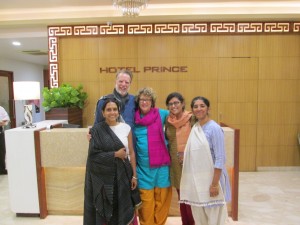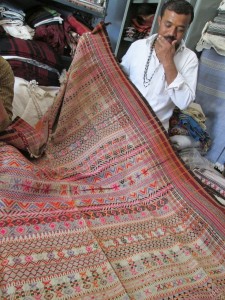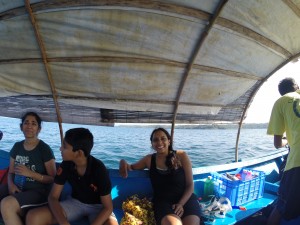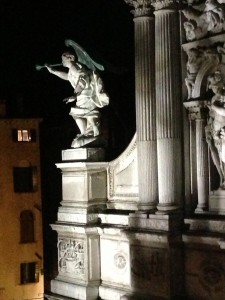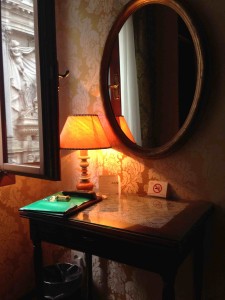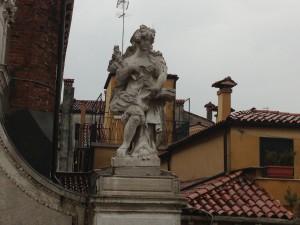I’m teaching two courses that are new to me this term — Curriculum Design and Artist Teacher Studio. Both are taught to advanced students who are student-teaching or interning in Community Centers. They’re exhausted. They’re also fantastic artists who’ve just completed a Capstone course in which they developed rich bodies of personal work. And now, they’re teaching, and we’re using the course to explore how one maintains an art practice while they’re busy using up all their creativity and passion to meet the needs of their students. Sound familiar? It’s the question every artist faces when teaching: How do you make art and teach at the same time?
It was a rough start. I’ve been teaching for 38 years, but never these courses. And I just returned from sabbatical, so my clutch was lurching as I tried to get in gear. Curriculum has gone smoothly enough — that’s my turf, and I’ve done it in so many different contexts, that this is just a new version of the game. But Artist Teacher Studio — that’s all new. I assigned myself this course so I’d force myself to maintain a making practice — something I’ve left behind for years and want to renew. I did a lot toward that during the sabbatical — setting up a studio space in my home, writing daily reflections — every single day — and keeping a sketchbook. I developed entry ideas for a number of artworks — a Claim Kit, a Vanquish Kit, a series of sculptures or puppets that are turning into animation (which I have to learn) about judgment and intuition. Some responses to India, in patterns and colors. Some drawings of places I visited. And now it’s time to realize them. Intake of breath.
That’s what I’ve never done — set a regular practice of making and producing works. I’ve done it in courses, and I’ve done it sporadically in vacations and periodically, but I’ve never had a regular studio practice. And I want that. But it’s frightening. I have loud, clever voices that tell me I’m not good enough, I can’t get good enough, I suck. But I’m working through that — as Kathleen Marsh at Boston Arts Academy tells her students, “The only way is through.” So I’m working through it. Keep breathing, Lois.
Today, I had a breakthrough. I realized that I’m designing a studio curriculum for the Artist Teacher Studio class, and that’s an example of how to design curriculum for the Curriculum Class. It came to me as I noticed that my fountain pen — purchased in December for journaling ONLY, never to be taken from my desk — was running out of ink. It runs out about every three days, and I have a bottle in my desk drawer to fill it. But usually, up to now, I’ve written until the ink stopped flowing; then I realized I needed to fill it. Today, though, I recognized the decrease in flow that precedes the stopping of ink. I’m gaining intimacy with my pen — my artist tool.
It got me thinking about Develop Craft. Artists love their tools and materials. Maybe that’s one of the reasons so many art curricula focus on skill development? (It could be other things — more pernicious — like that’s the easiest thing to see.) But the teaching of skill development too often starts with HOW. And that’s not a generative starter. What is a starter is passion, the love, the INCLINATION to care about materials and tools and using them well to express an idea. We have to start with MEANING and then turn to tools and materials to help express it artfully. That pushes the need to learn — I MUST learn these skills (for example, animation, in my case) in order to make this work about this idea that’s so important to me.
So, yes, teach Develop Craft. Teach students HOW to use the materials and tools of the discipline they’re learning. But don’t start with HOW. Start with WHAT (which tools? which materials), which flows from WHY. What (a) tools and media do we need to (b) make the thing we need to make to (c) say what we need to say.
That’s when I realized why it’s so disquieting to see my students, when asked to come up with 9 Dispositions or Behaviors that they want to teach (monthly topics for a year), come up with so many materials-centric themes. Where’s the habit that they want their students walking out the doors with, infecting them inside and that now lives therein? Color relationships? Book binding? 3-point perspective? Why have they reverted to skills and media and drifted from idea and meaning?
I think it’s two-fold: (1) schools win (thanks for the phrase, John Crowe). They’re in schools and they’re seeing curriculum based on elements and principles. “They have to learn the rules to break them.” Well, I don’t think that’s good learning science — it just doesn’t take human psychology into perspective. So that’s one reason. The other is (2) they love materials and tools, because they’re artists. These are delicious to an artist — the way a pencil rolls across the tooth of the paper, resisting and floating. The way the sharpener cleans the blade and refines its edge, honing it to perfection. The way the corner sits in the design, snugging into the edge seamlessly. These are all moments of deep satisfaction, where the hand/body unites with the mind. But that’s not what the students experience in a skills-first curriculum. For them, it’s strangeness, otherness, and the fear and doubt associated with that.
What they need is befriending. They need to have a need for these tools and materials because there’s something they want to do. And then, as they recognize vaguely the beginnings of what they’re trying to do, they find a need for tools and materials, techniques and control. So, how do we set up curriculum to capture them?
A Befriending Curriculum
First, the teacher and student need to get to know the student. What drives him or her? What are her passions, fascinations, and perplexities? What catches his attention no matter what? What does she notice?
After that, it’s time to enter into conversation with these ideas in art. Who else is fascinated by these ideas? What are they doing with them? How are they addressing them? Through film? Sculpture? Painting? Paper-making? Design? These are the people the student needs to be in conversation with — the contemporary and historical artists, the peers, the local artist community.
Third, it’s time for the teacher to facilitate some budding friendships. Set up “play dates” with different artists, different peers, different materials and tools. These “play dates” are assignments that are open and exploratory — and low stakes. Like a cocktail party, or a speed date (thank you, John Crowe!), or a handling table, or making 50 mistakes (another John Crowe assignment), they’re a chance to meet a tool or material that we might want to befriend.
Fourth, it’s time to deepen selected friendships. To develop familiarity with the tools, material, or technique. But that’s motivated internally, not imposed from outside. We need tools and material and technique so we can say what we need to say, do what we need to do, and make what we need to make. John Crowe calls this “going steady.” But it could be joining a play group. Or a club. Whatever metaphor, it’s the time to push a commitment to something and gain skill through regular, socially facilitated experiences.
Fifth, it’s time to push the boundaries. If we’ve developed familiarity, now it’s time to develop intimacy. To go where you won’t go with just anyone — to take the tool or material or technique inside and own it as important, as part of you, as YOURS. That means lots of exploration and practice, lots of different contexts, so the student begins to intuit, to sense what the tool can do to support meaning and purpose–his meaning, her purpose. Lots of challenges with scaffolds to support the inquiry toward solutions. This phase means committing to a body of work, a pursuit, a product.
Sixth, the student has to go public with the work to bring it and his own process into conversation about it with other artists. Work has to be seen, and the artist needs to talk about it to the audience of other artists, family, and broader publics. What IS this work? Why is it important? Who does it speak with? Who needs it?
And at that point, it’s time to let the work go and start some new friendships. You can return to one from before and build it new. But you have to go to ground and begin again.
What a different model of developing craft from that we see in so many schools where skill-development is king and no one notices that the students don’t know what to do with them — they just do what the teacher says (or don’t) and let it be. A few will learn to use their skills for what they need to make, but many won’t. And our goal is to catch a lot of fish in our nets of purpose. To do that, we have to start with self-investigation of desires and needs, then exploration of possibilities, followed by play dates and deepening relationships to ideas through materials or actions. At least, that’s how I’m thinking of studio curriculum today. It feels like what artists DO — and isn’t that how we want to set up our “junior versions” so students can learn to play the whole game? (That metaphor is from Dave Perkins’ book, Whole Game Learning).

